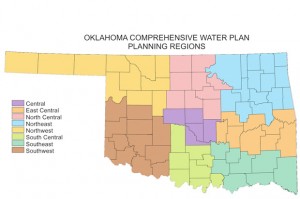
The eight planning regions from the 1995 update of the Comprehensive Water Plan. A ninth region would be created in the panhandle if SB965 becomes law.
OWRB


The eight planning regions from the 1995 update of the Comprehensive Water Plan. A ninth region would be created in the panhandle if SB965 becomes law.
OWRB

OWRB
The eight planning regions from the 1995 update of the Comprehensive Water Plan. A ninth region would be created in the panhandle if SB965 becomes law.
Oklahoma’s state water authorities want to move from population-based to regional appointments to the Oklahoma Water Resources Board.
The change follows the 2012 update of the state’s Comprehensive Water Plan, which calls for regional planning.
Senate Bill 965 would change the composition of the OWRB, giving less-populated areas of the state an equal say in how Oklahoma’s water is used. It would not, however, create new planning districts, which is what the OWRB advocates for.
The idea with regional planning is that more local control will result in smarter, more judicious use of water that benefits all parts of the state equally.
But Oklahoma’s water isn’t distributed equally. Neither are drought or people, and some in densely populated areas are worried the change will keep them from getting their fair share.
Pete White, chairman of the Oklahoma City Water Utilities Trust told The Oklahoman’s William Crum changing the way the OWRB is picked would be an “atrocity:”
“It puts control of resources that belong to all of us into the hands of a few of us,” said White.
Water has been a key factor in producing the benefits that flow to the entire state from the “economic engine” generated by people who live and work in the cities, White said.
Currently, the Oklahoma Water Resources Board, which is charged with managing the state’s water and appointed by the governor, is comprised of four at-large members, and one member from each of Oklahoma’s five congressional districts, which are all equalized for population.
White doesn’t like the idea of sparsely populated rural areas making decisions that benefit them — refusing to share water with other districts, for example — at the expensive of people in Oklahoma City or Tulsa. The paper illustrates his concerns:
Oklahoma, Cleveland, Canadian, McClain and Pottawatomie counties in central Oklahoma — with an estimated 2012 population of 1.2 million — would get one board member.
Beaver, Cimarron and Texas counties in the Panhandle — with an estimated 29,474 residents — would get one board member.
Nine counties in southeastern Oklahoma with an estimated population of 184,583 also would get one board member.
Other states, including Texas, have already moved from population to region-based planning. The State Chamber’s Arnella Karges told StateImpact earlier this year that the results have been mixed.
[module align=”left” width=”half” type=”pull-quote”]
“Where you can’t make compromise about how and where to use water, nothing occurs. Development shuts down.”
[/module]
“There are regions in Texas where it has worked well. There are regions in Texas where is has not worked well. There are some places where they’ve been able to make compromises. There are places they haven’t,” Karges says. “Where you can’t make compromise about how and where to use water, nothing occurs. Development shuts down.”
But before finalizing the state’s 2012 water plan, the water board held numerous meetings to get the public’s input.
Executive Director J.D. Strong says regional planning was “the most popular water plan recommendation among citizen participants because it allows them to engage more formally in how water resources are planned at the local level and managed by the state.”
Versions of SB 965 passed both houses of the state Legislature, but White tells The Oklahoman he’s hoping for intervention:
White said Friday that he expected the courts would kill the idea, if the Legislature or governor don’t kill it first.
CLARIFICATION: The OWRB wants to make clear that SB965 would regionalize the membership on the water board, and would not actually create new planning districts, which was their recommendation in the 2012 update of the Comprehensive Water Plan.